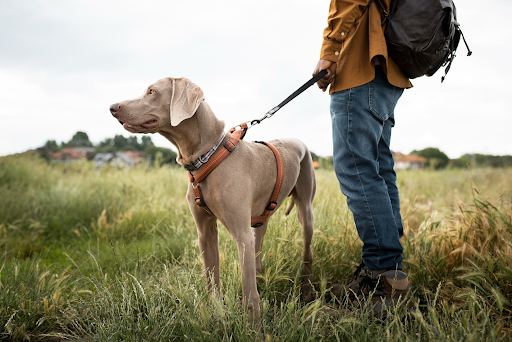
Dog Leashes for Pullers: Which Ones Actually Work?
If you have a dog that loves to pull on walks or while on a leash, you know how challenging—and sometimes even dangerous—it can be. It can scare other dogs and passersby, and put the dog’s health at risk.
Here’s where the right leash plays a major role! Not only does it make walks and outings more enjoyable, but it also improves control and safety. It can also be an essential tool for training and to help build the bond between you and your dog.
However, with so many leash options on the market, it can be easy to feel overwhelmed in your choice. Fortunately, with the right tips and knowing the factors to look for, you can find the right model designed to help with strong pullers! Let’s learn more in this guide!
Best Leash For Dogs That Pull: Types of Leashes for Pullers
There are many types of dog leashes available today. Each is designed with unique features and mechanisms of action that may help manage pulling and ensure safer, more comfortable walks for both you and your dog.
Each type is also tailored to specific needs, dog characters, and situations. Here’s an overview of the most common leash types for dogs that pull:
-
Adjustable Leashes: These leashes allow you to easily change the length. This can help you provide your dog with more or less freedom as needed. Adjustable length leashes are highly versatile, as they can help in different environments and are helpful for training.
-
Heavy-Duty Leashes: These models are built with stronger materials and reinforced clips to help you better manage large or strong dogs who tend to often pull or lunge.
-
Double-Handled Leashes: These leashes are equipped with two handles. One is usually located at the end and another closer to your dog. With this design, you can gain extra control, especially in environments that are crowded or have plenty of distractions, leading the dog to pull more.
-
Bungee Leashes: These leashes incorporate one or more stretchable sections, but they also have fixed handling points that allow you to quickly gain control as needed and better lead your dog. The stretchable section can help to absorb sudden pulls and shocks, reducing strain on your arm and your dog’s neck.
In the next sections, we’ll look closer at how each performs for strong pullers.
Adjustable Dog Leashes
Adjustable leashes are designed to offer flexibility. They allow you to change their length according to your walking environment, and they can also be helpful during training sessions. Ultimately, they can be the go-to option if you often walk with your dog in different environments that require you to closely and quickly change how much freedom your dog has to move.
Pros:
-
Adjustable length makes close control easier and allow for more freedom
-
Useful for training and different walking scenarios
-
Easy to shorten in crowded or high-traffic areas
-
You often only need one leash only, as it can be very versatile.
Cons:
-
Some mechanisms can wear down over time. Maintenance and looking for areas of wear and tear is essential to prevent accidents caused by a sudden pull.
-
May not be sturdy enough for very heavy pullers or large dogs
-
Can be heavier than standard leashes
Who Is It For?
Adjustable leashes work well for medium breeds, especially during training. Owners who often walk in different areas may find these leashes useful and versatile.
Dog Leash Heavy Duty
Heavy-duty leashes are specifically designed to guarantee sturdiness and strength. They are often built using materials like reinforced nylon, climbing rope, or even steel cables. While they may be suitable for many dog breeds, they are meant for large, powerful dogs that often pull. However, learning to handle these leashes is essential to make the most of them.
Pros:
-
The construction made of extra-strong materials can prevent breakage even with strong pulling.
-
Reinforced hardware can help control or even prevent sudden lunges
-
They are made to be durable and long-lasting to support regular heavy use
Cons:
-
They can be heavier than other leashes and sometimes less comfortable to hold
-
They offer limited flexibility in length or movement
-
May not be necessary for small or non-pulling dogs
Who Is It For?
These models are best suited for owners of strong, large breeds such as Huskies, German Shepherds, or Pit Bulls. They can also be used for dogs that tend to break weaker leashes or for walks in areas with many distractions.
Double-Handled Leashes
This leash type features a standard loop handle at the end and a second handle closer to the dog’s collar. This design allows you to quickly and closely control your dog’s reactions, even in busy environments. Because of these features, these leashes are becoming popular to improve safety and control in urban areas.
Pros:
-
Provides freedom to the dog and also, as needed, immediate, close control
-
It can be great for crossing streets or navigating crowded environments
-
They are often made with heavy-duty materials
Cons:
-
May be bulkier due to extra handle
-
Can tangle if not managed well
-
Typically, they are not as adjustable as other models in length
Who Is It For?
These leashes are ideal for owners of medium to large dogs with unpredictable behavior or those who walk in busy urban areas. They may also help with strong, energetic breeds that may require close control in specific situations.
Bungee Leashes
Bungee leashes are specially designed to incorporate a stretchable elastic section that absorbs shock and sudden pulls. They can be a great option to minimize strain during walks, but they may work well with pulling dogs of small or medium breed.
Pros:
-
Reduces loads or strain from sudden pulls
-
Makes walks more comfortable for both owner and dog
-
Useful for active breeds
Cons:
-
Too much stretch can decrease control, especially in the case of powerful pullers
-
Some versions may wear out quickly with frequent use
-
Not ideal for situations that require close, precise control
Who Is It For?
They are best for small and medium breeds with lots of energy, such as Labradors or Retrievers. They can help you avoid arm strain and could be suitable if you regularly walk your dog in large areas.
What to Look for in the Right Leash for Pullers
Above we have seen different types of leashes and their pros and cons. However, there is no one-seize-fits-all solution when it comes to choosing the best option for your dog! That is why it is important to identify the factors that can make a difference and choose based on your dog’s character, personality, energy levels, size, and training level.
Here’s what matters most:
-
Strength and Material: Especially for large dogs, you may want to opt for heavy-duty nylon, climbing rope, or leather that can withstand strong, sudden pulls. These materials also can resist fraying or snapping, making them a long-lasting option.
-
Length and Adjustability: Adjustable leashes allow you to adjust the length and the control level, which make them perfect for navigating busy streets or open parks.
-
Handle Comfort and Grip: Padded or ergonomically designed handles can play a role in helping you avoid hand fatigue. This is important to continue controlling your dog throughout their walks, from start to end. Plus, these handles provide a secure grip, which is essential during energetic walks.
-
Clip Strength and Security: Especially when investing in heavy duty models, you’ll want them to be made of strong, rust-resistant hardware to prevent accidents, such as becoming unclipped or breaking. This is essential when leading powerful breeds and to manage unexpected lunges.
-
Weight and Suitability for Dog Size: The leash should be heavy enough for durability, but not so bulky that it becomes uncomfortable for you and your dog! So, test out different options in advance.
-
Visibility and Reflective Elements: Reflective components or high-visibility colors are essential. They improve safety during early morning or evening walks as they make you and your dog easier to see.
The features above are essential for your comfort and for effectively controlling your dog, but choosing the right leash is also crucial for your dog’s wellbeing. A sturdy leash does not just make walks more comfortable—it also helps prevent accidents, reduces strain on your body, and supports better training habits.
What’s more, the right design can protect your dog from injury during sudden pulls and ensure long-term health by avoiding neck or joint problems. Ultimately, investing in an appropriate leash helps create safer, calmer, and more enjoyable walks for both you and your dog.
With so many options available, selecting the best leash for a pulling dog can feel bewildering. This is especially true if you are a first-time dog owner or suddenly find yourself dealing with a dog that pulls. However, with the right tips and strategy, you can choose a leash that offers both safety and comfort.
If you are unsure how to start, take time to review the options above. Remember that buying the right leash can have many benefits, from building better training habits to strengthening your relationship with your dog. So, it’s an investment worth making!
